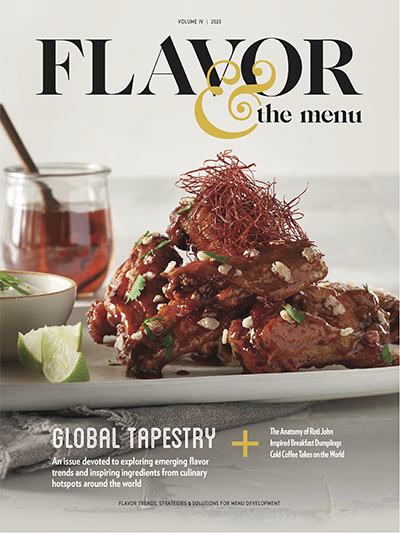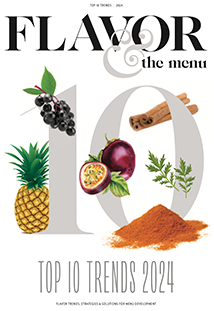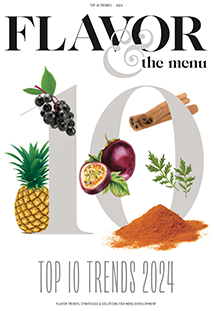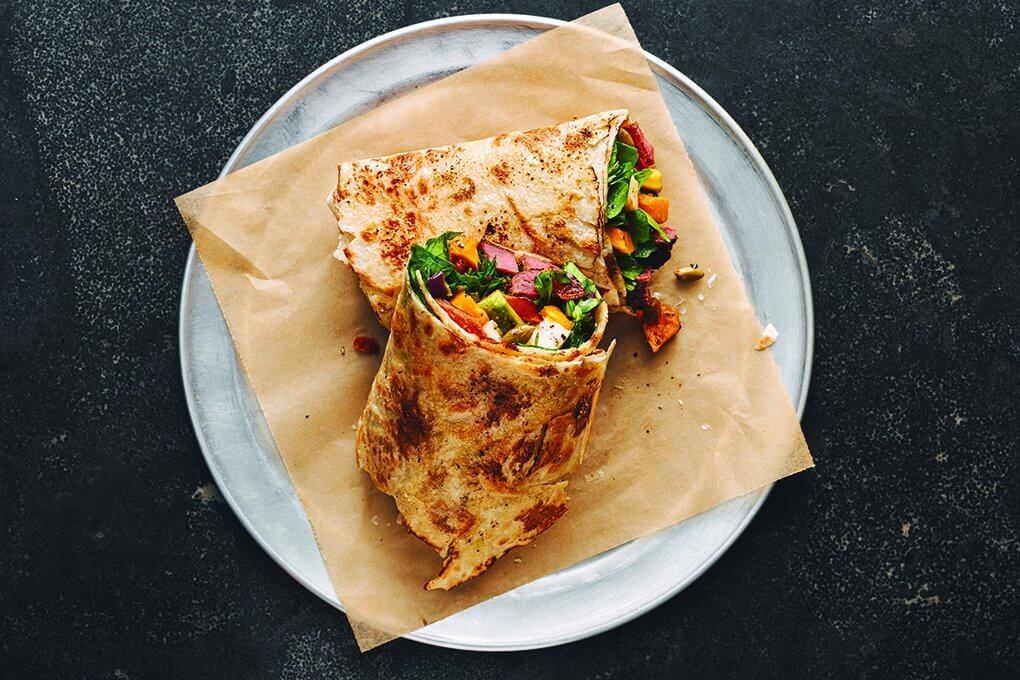The fast-casual segment has been leading innovation for some time now, surprising and delighting consumers with flavor-forward builds and strong brand narratives. And with that surprise and delight, this segment has moved the needle on guest expectation.
Fresh, mindful, bold, wholesome—these are terms that are part of today’s vernacular, replacing the now-stale demand for simply fast food. But despite these successes—or perhaps because of them—fast casual is seeing a bit of a slowdown.
Some analysts are calling out a decline in sales while others are reporting a slump in growth. “Fast casual has been a haven for those wanting to drive sales,” says Matt Harding, director of culinary at Piada Italian Street Food, a fast casual based in Columbus, Ohio.
“We’ve got so many burger places, pizza places, you name it, coming onto the field. You reach saturation, and so the winners shake out. Good isn’t good enough. Those who win have clearly defined flavors. They’re at the top of the flavor curve.”
Flavor, as usual, is the name of the game today—the challenge comes from pushing boundaries without alienating consumers.
Fast casual is also seeing a pull in focus, shifting from its origin story of merely bridging the gap between fast food and casual dining. “Fast casuals are emerging that are aligning more with fast-food models but with serious credibility in flavor and authenticity, like The Halal Guys, for instance,” says Rachel Kalt, creative director at The Culinary Edge, a consultancy based in San Francisco.
“On the other end, you have concepts emerging that are chef-driven with credibility as super-premium ‘fast’ food, like Souvla in San Francisco, a hip concept serving roasted meat sandwiches, salads and Greek yogurt.” The common thread, regardless of menu focus, is high-intensity flavors with built-in craveability.
As fast-casual concepts jostle for space in a now-crowded landscape, the ones that are thriving and growing possess the ability to build on successes while challenging themselves to anticipate the demands of an ever-evolving modern consumer.
We interviewed four fast-casual brands that are meeting this watermark. Their menus are vastly different from one another, but they are all in impressive growth mode. We tapped them for their insights on what’s working and how they’re evolving to stay current with modern flavor and dining preferences.
Forward Motion
Growth is always fueled by self-reflection, assessment and adjustment. “The requirement today is to have a much more dialed-in approach,” says Kalt. “That specificity is reflected in newer concepts hitting the market. Now, instead of pizzas, burgers or tacos, we’re seeing more adventurous themes, like Singaporean street food or Cuban food.”
Piada, an Italian concept with a focus on piadas, pastas and salads, launched in 2010, doubled in size in 21/2 years, and now has an expected growth rate of 25 percent for 2018. Specificity for this brand, says Harding, involves a more intense flavor focus. He reports that Piada rolled out a bigger LTO process in summer 2016, looking to expand its seasonal tie-ins. The Summer Avocado Piada, a hand-rolled Italian flatbread filled with roasted sweet corn and tomatoes, fresh avocado, arugula, mozzarella, pancetta and basil aïoli, claimed 17 percent of sales—that’s a 15-percent spike from the brand’s last LTO.
“That was really surprising for us,” says Harding. “It’s a huge percentage of guests ordering that item, which causes you to ask, ‘Why is it resonating?’ The flavors are bright and fresh and forward, so maybe that’s it. Or is it because this is what they’re looking for in this space, and this is an opportunity to develop more complex flavor builds? Previously, our builds were pretty straightforward.”
To answer the question of whether it was a singular success or an indicator of evolving flavor preferences, Harding rolled out a fall version of the piada, switching out summer corn for roasted butternut squash. “It did really well, too,” he says. “That solidified in our mind that you can create complex flavors and your guests will find it and love it.”
Next up is an exploration of breakfast fare. “We’re looking at the breakfast daypart—not necessarily about opening during morning hours, but adding breakfast items that will sell at lunch and beyond,” says Harding.
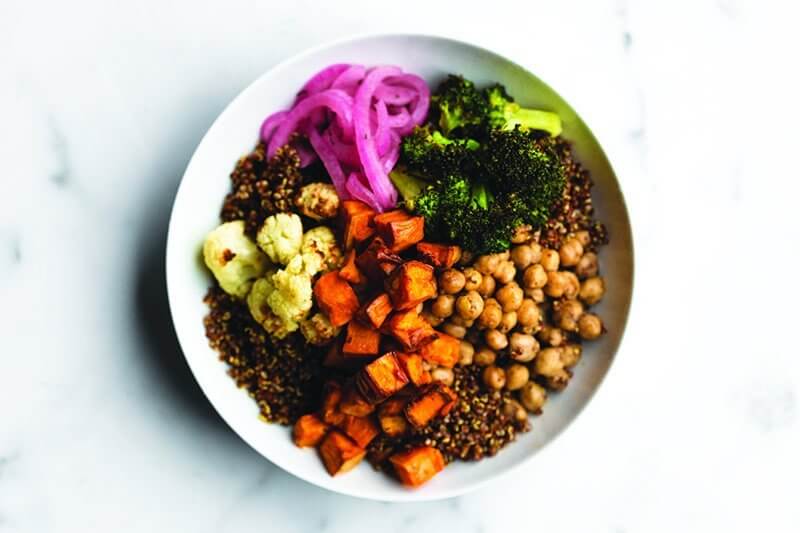 Piada Italian Street Food
Piada Italian Street Food Piada introduces a bowl build this fall with its Mediterranean Power Bowl: red quinoa, green harissa, roasted sweet potato, broccoli and cauliflower, pickled red onion, za’atar chickpeas and cilantro.
Cava, a Mediterranean fast casual based in Washington, D.C., looks forward by continuing to innovate around flavor profiles. Starting with one unit in 2011, the brand now boasts 34 and is expecting to reach 40 by the end of the year.
“We are constantly experimenting with new flavors,” says Nikki Rappaport, director of innovation for this build-your-own, better-for-you fast casual.
She cites the R&D behind the brand’s successful housemade juices program as an example. “We test several versions of one drink with various levels of herbs and spices to find the most balanced one that both introduces our customers to new flavors and has broad appeal.” Cava’s Lemonade with Turmeric and its Grapefruit & Mint Raspberry Shrub are two examples of beverages that strike that balance.
She and her team also push innovation through salad dressings, adding both Turmeric Tahini and Green Harissa as seasonal options. “We were only planning on keeping them for a few months,” says Rappaport. “They were so popular, we actually debuted these two flavors in our launch of retail dressings, and Green Harissa has remained on our menu full time.”
Further exploration in flavor play, particularly with heat levels, is in the works at Cava. “Chef Dimitri Moshovitis is always looking to bring flavors from his Greek heritage,” she says. “My favorite things we’re working on include slow-cooked meats, playing with spice combinations for all ingredients, and finding more opportunities to bring heat to the menu.”

Like Cava’s fresh seasonal juices and teas, beverage development that reflects the brand and the season is a smart strategy for fast casuals.
Vitality Bowls, a self-proclaimed superfood café concept based in San Ramon, Calif., is finding continued success through landing on craveable combinations that tout health and wellness. Currently, this brand that serves up açai bowls, smoothies, juices, paninis and salads has 33 units, but anticipates breaking 50 by the end of the year, according to Tara Gilad, co-founder and COO.
“The future of fast casual is in the health and wellness space,” she says. “Younger generations are more educated and more concerned about their health. But of course, it has to be delicious. We rely heavily on word of mouth—once they try it, they love it.”
Vitality Bowls offers monthly bowl specials to energize the menu and introduce guests to new ingredients. The Pumpkin Bowl, a fall offering, is a top-selling item. “Customers are obsessed with it, and start asking for it well before October,” she says. It’s a base of açai blended with almond milk, organic raw pumpkin, cinnamon, banana and strawberry, topped with organic hemp/flax seed granola, banana, strawberry, organic sprouted pumpkin seeds, honey and nutmeg.
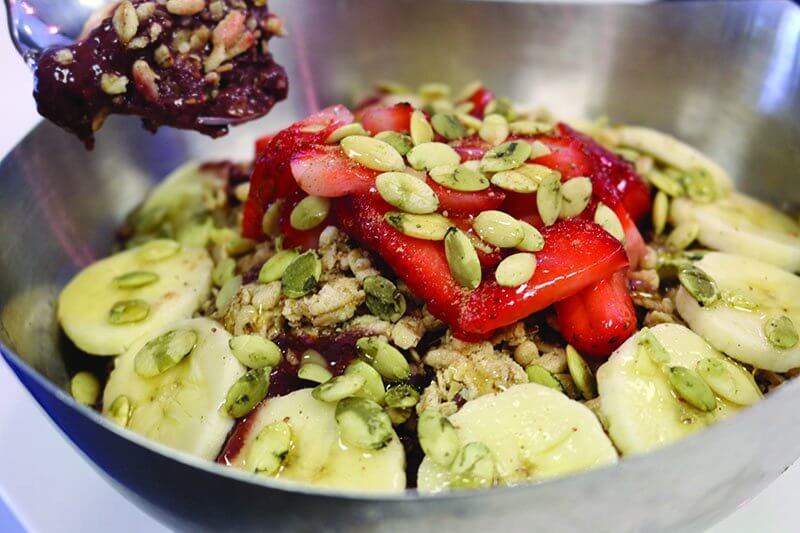 Vitality Bowls
Vitality Bowls The Pumpkin Bowl is a top-selling fall special at Vitality Bowls. An açai bowl with organic pumpkin in the base, it was a surprise hit for the brand, indicating enthusiasm around seasonal flavor adventure.
The Halal Guys offers a different case study. This Middle Eastern fast casual is on fire, moving from a street-cart empire in New York that was founded in 1990 to a jump to brick-and-mortar in 2010 that has now grown to 53 units across the country. By the end of the year, they project a count of more than 70 units both here and abroad.
As this brand—known for its craveable, filling platters of chicken and gyro with a signature white sauce—is new to fast casual, its insights stem from adaptation rather than evolution. “We’re known for a simplistic, straightforward menu,” says Andrew Eck, director of marketing. “We have to see how our fans respond to an expanded menu that fits this model better.”
The Halal Guys has added sides, including hummus, tabbouleh and baba ghanouj. It also released its first LTO recently: Spicy Hummus. “We were extremely pleased with the result,” Eck says. “We’re discussing internally about overall response and what we are able to achieve for overall sales mix, and we’re exploring adding more LTOs to the mix.”
One thing Eck is carefully guarding is the brand’s reputation—it’s literal street cred. “My biggest task is protecting the vibe and electricity we’re known for in the streets of New York and making sure that translates into a strip mall in California.”
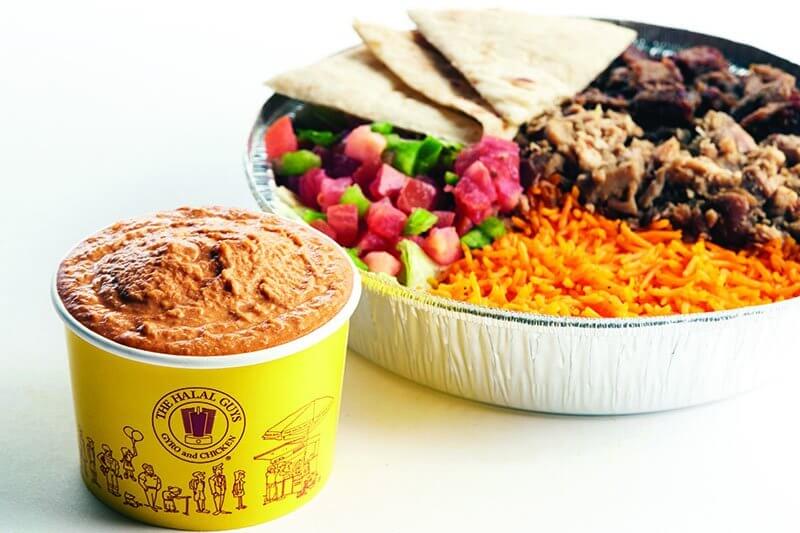 The Halal Guys
The Halal Guys The Halal Guys earn street cred with authentic Middle Eastern fare. Strategic menu additions include new sides like Spicy Hummus.
Authenticity. Again.
The importance of authenticity for all segments today cannot be overstated, propelled by a consumer who values transparency, honesty and narrative. As the fast-casual space evolves, authenticity becomes an even bigger player, helping separate the wheat from the chaff.
“Brands are leveraging the demand for big flavors, tapping into a driving desire for authentic, adventurous experiences,” says The Culinary Edge’s Kalt.
For The Halal Guys, authenticity is inherently linked to its brand promise. Its first customer base was Muslim cab drivers in New York, looking for halal meals while on the road. The brand developed a rabidly loyal fan base because of its authentic Middle Eastern menu: grilled chicken thighs marinated overnight in Middle Eastern spices, beef gyro, spiced jasmine rice, pita and a famous white sauce that customers have been trying to decipher for years. A quick search on YouTube reveals earnest fans trying to replicate it.
“What has allowed us to flourish in a flatline business is authenticity and origin of our brand,” says Eck. “We’re an overnight sensation 20 years in the making.” The Halal Guys’ success is an indicator of how important authenticity, craveability and word-of-mouth marketing is. As this brand flourishes in markets outside of New York, its narrative may soften, but if it can protect its authenticity, the future looks bright.
Piada’s Harding shares an important perspective on authenticity: “If you roll out a harissa, you need to know what the traditional one tastes like. Once you understand that flavor, then think how your guests can consume it,” he says. “We could never get away with ’nduja as a spread, but we could put it in a mayo or a hummus, where our guests couldn’t quite place it, but would find it intriguing. That’s almost better than the original for us—while still being an authentic experience.”
He uses chorizo as another example. “If you’re doing chorizo, it has to be kick-ass chorizo. Authentic flavors don’t need to be presented authentically. You can do chorizo in a taco or a piada—the flavor has to be authentic, but it can be presented in a way that fits your brand,” he says.
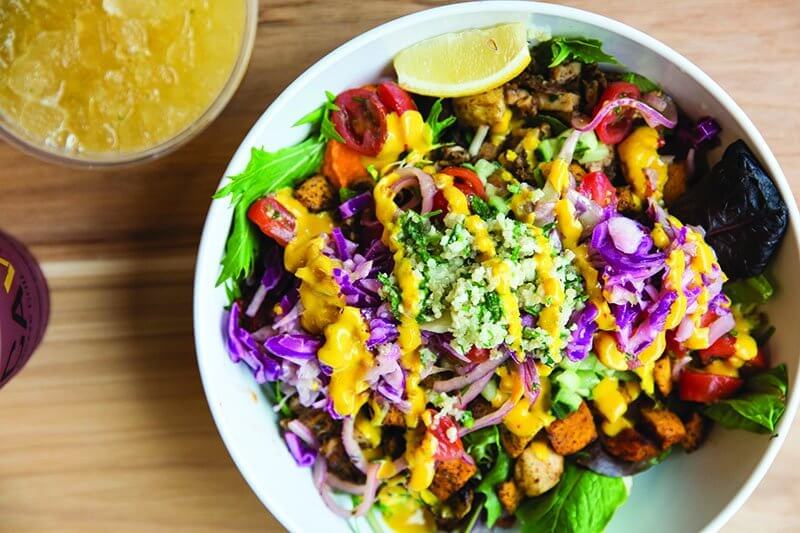 Cava
Cava Better-for-you Mediterranean fast casual Cava innovates with new flavors through salad dressings like Turmeric Tahini and Green Harissa.
Consumer Reach
“Knowing your customer” is baked into everyday marketing, but stretching for new customers takes savvy, insight and a touch of bravery. “We attract older Millennials,” says Harding. “Our guest is a young professional with a young family and a higher disposable income. They’re mobile and they’re looking for great food—that’s our sweet spot.”
But Piada wants to bring in younger consumers, too. “They’re the holy grail,” he says. “The key is flavor and authenticity.” A few menu additions are designed to lure in younger diners, with authentic, interesting flavor combinations leading the charge. In October, Piada is rolling out a porchetta sandwich that’s been in the works for 18 months. “Ours is both typical and atypical, with fennel, garlic, rosemary—and we added lemon peel and dried mushroom, which makes the pork ‘porkier,’” he says.
He serves it on a bianca roll with sliced fennel and pickled red onion. “The fennel provides the crunch and sweetness, while the onion cleans up the unctuousness of the pork. It might be challenging for the guest, but we want an authentic handheld that has big flavors in it.”
Piada is also expanding into bowls, adding a Mediterranean Power Bowl with red quinoa, green harissa, roasted sweet potato, broccoli and cauliflower, pickled red onions, za’atar chickpeas and cilantro. “It’s a departure for us, but we had a hole in our menu,” says Harding. “Pasta carbonara is great, but you don’t always want to eat that way. This gives them yet another choice.”
Vitality Bowls is also going after the younger demographic, and it’s aiming efforts at the brunch daypart with two new rollouts: superfood waffles and an “eggnini.”
“Our superfood waffles are great for the brunch crowds,” says Gilad. “And they’ll give our customers more breakfast options throughout the day.” The waffles, boasting quinoa, chia seeds, flaxseed and pitaya, are currently in test at all locations. The eggnini is a breakfast panini with pesto, mozzarella, scrambled egg and spinach.
The Halal Guys has noted a shift in demographic as the fast casual moves across the country. “What we’ve seen in our first two corporate-owned brick-and-mortar concepts was a cost-conscious, young adult consumer,” says Eck. “Our consumer base has shifted to more established 28 to 35 year olds. Our initial assumption was in the 18 to 25 range.”
What’s clear across these brands is that a growth strategy leans heavily on understanding the flavor preferences of different demographics, then perhaps stretching to reach new ones.
“We all have to keep innovating to keep our guests coming in,” says Harding. “When you give them something special, something different, something with really good developed flavors, that’s what’s craveable, and that’s what they’ll come back for.”

